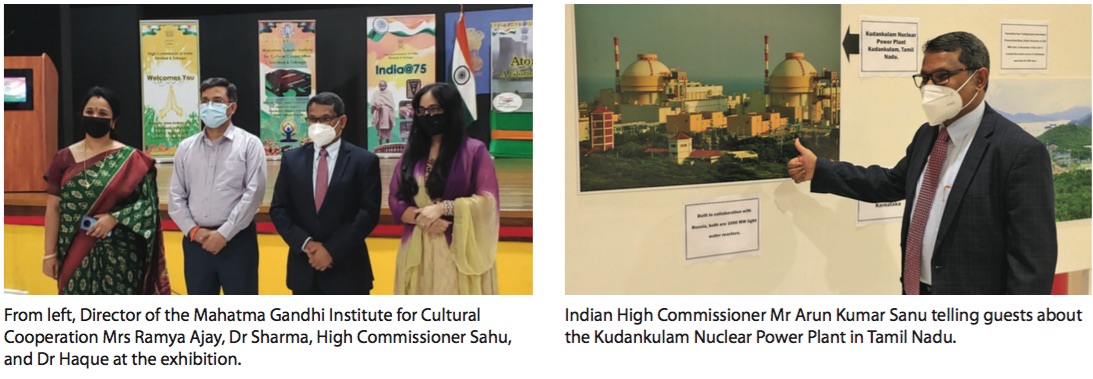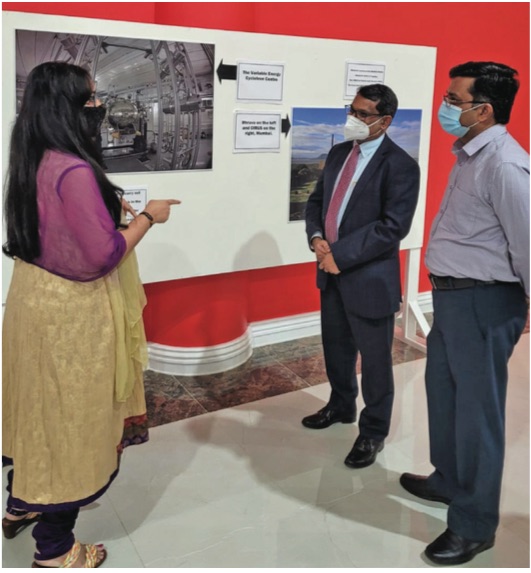Exhibition shares India’s proud atomic energy past, plans for its tomorrow
Energy – the lifeblood of modern, industrialised societies – holds a special place in our economies, ambitions, and imaginations. We furiously debate its impact on the environment. We look with trepidation when its global commodity prices rise or fall. And if energy is one of the most important topics of our age, nuclear energy is the most seductive and terrifying member of its family.
In the case of India, the position of its policymakers and planners is very clear:

“... For the full industrialisation of under-developed countries, for the continuation of our civilisation and its further development, atomic energy is not merely an aid, it is an absolute necessity...”
The quote is from Homi Jehangir Bhabha, a Nobel prize-winning nuclear physicist widely regarded as the father of India’s nuclear programme. It was shared by Dr Shirin Haque, Senior Lecturer in Astronomy at UWI St Augustine’s Department of Physics at the recent exhibition, “Atomic Energy of India: A Glorious Past, a Resplendent Future”.
The three-month exhibition, which opened in February, looked at the rise of India’s atomic energy industry, and showed where the nation intended to take the industry in the coming years.
“Nuclear energy is the fifth-largest source of electricity for India, and is an essential component of its energy security and environmental protection,” said Mr Arun Kumar Sahu, High Commissioner of India to Trinidad and Tobago. “India has over 23 nuclear reactors in seven power plants, producing 6,780 MW of nuclear power while reducing its contribution to global greenhouse gases.”
The High Commissioner added that, “India plans to increase the contribution of atomic energy to 25 percent of the total power capacity in future.”


The exhibition was organised by the High Commission and the Mahatma Gandhi Institute for Cultural Cooperation. It was held at the institute’s headquarters in Mt Hope, and gave visitors a glimpse into the power plants (such as Kakrapar in Gujarat and Kudankulam, the largest nuclear power plant in India), products such as radiopharmaceuticals (drugs containing radioactive isotopes), and medical treatments like brachytherapy (radiation therapy).
Apart from the impressive advances India has made in atomic power, the presenters were keen to stress its necessity:
“As we know, due to changes in our living style and [power usage], world energy demand is increasing day by day. To meet this rising energy demand, countries worldwide are exploring various resources, including renewable and non-renewable. Oil and gas, hydro, thermal, solar, wind and nuclear are popular energy choices,” said Dr Davinder Sharma, Head of the Department of Physics at UWI St Augustine, who also spoke at the exhibition.
“In Trinidad and Tobago,” he said, “we have surplus electricity, generated mainly by the natural gas, but countries like India, with a huge population of around 1.38 billion people, where oil and gas is limited, have been exploring many sources like hydro, thermal and nuclear.”
Dr Haque also pointed out Prof Bhabha’s analysis of India’s limited alternatives to nuclear energy in her presentation. He showed that, at the time, India had 16 percent of the world’s population (today, it is 17.7 percent), but only about six percent of the world’s coal and less than one percent of its oil and gas. However, the country has about 32 percent of the world’s thorium reserves. Thorium is a radioactive metal found in nature that can be used in the process to generate nuclear power.
Her presentation, however, did not gloss over the dangers of nuclear power. Titled “Nuclear Energy: A riveting tale of the best and worst of humanity,” she charted the scientific and historical rise of nuclear energy, all the way back to 1905 and Albert Einstein’s equation, e=mc2. The equation showed that mass and energy were interchangeable, setting the groundwork for nuclear power. Einstein and his fellow scientists were partly responsible for the development of the atomic bomb by the US because they feared Nazi Germany would develop it first. He would spend the rest of his life warning the world of the dangers of nuclear weapons.
Apart from their use as weapons, there have been nuclear and radiation incidents at power plants such as Three Mile Island in 1979 in the USA, Chernobyl in 1986 in Ukraine, and Fukushima in 2011 in Japan. There is also concern about nuclear waste, a by-product of nuclear power generation, which is both harmful to the natural environment and human life, as well as extremely long-lasting.
Nevertheless, numerous studies have shown that nuclear power is safer for the environment than fossil fuels. One energy sector writer described it as “virtually carbon-free”. In fact, one of the benefits of India expanding its atomic industry is to address the climate crisis. At last year’s COP26, Indian Prime Minister Narendra Modi pledged that the nation would reach net zero emissions by 2070.
“In order to fulfil its commitments to the Paris Agreement, India has started exploring solar and wind resources at large scale. Due to the huge population and hence energy demand, India went with the option of power generation, using atomic and nuclear energy,” said Dr Sharma.

Globally, as the climate crisis becomes dire, nuclear power is becoming attractive once more to meet emissions goals. In his presentation, Dr Sharma said that the Department of Physics, “understanding the importance of atomic and nuclear physics” had started a new course on Fundamentals of Atomic and Nuclear Physics. Dr Haque, along with Dr Roger Andrews (lecturer in the Physics Department), proposed and are currently teaching the course.
“At the postgraduate level,” he said, “we also have an advanced course on atomic and nuclear physics, which focuses on its application towards medical/health services.”
If we are in the nuclear renaissance, a time of renewed risk and reward, there is no denying that India is both a pioneer and a leader in its future trajectory. The work of scientists like Professor Bhabha alongside leaders such as Prime Minister Jawaharlal Nehru have led to the evolution of one of the world’s leading atomic energy industries and there is much more to come.
Giving a brief history of Indian thought and science through the ages, High Commissioner Sahu said “carrying this tradition of scientific knowledge, India has approached the nuclear sector for the welfare of the people.”